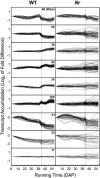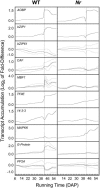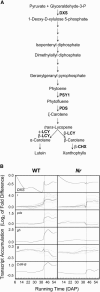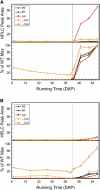Transcriptome and selected metabolite analyses reveal multiple points of ethylene control during tomato fruit development
- PMID: 16243903
- PMCID: PMC1276022
- DOI: 10.1105/tpc.105.036053
Transcriptome and selected metabolite analyses reveal multiple points of ethylene control during tomato fruit development
Abstract
Transcriptome profiling via cDNA microarray analysis identified 869 genes that are differentially expressed in developing tomato (Solanum lycopersicum) pericarp. Parallel phenotypic and targeted metabolite comparisons were employed to inform the expression analysis. Transcript accumulation in tomato fruit was observed to be extensively coordinated and often completely dependent on ethylene. Mutation of an ethylene receptor (Never-ripe [Nr]), which reduces ethylene sensitivity and inhibits ripening, alters the expression of 37% of these 869 genes. Nr also influences fruit morphology, seed number, ascorbate accumulation, carotenoid biosynthesis, ethylene evolution, and the expression of many genes during fruit maturation, indicating that ethylene governs multiple aspects of development both prior to and during fruit ripening in tomato. Of the 869 genes identified, 628 share homology (E-value < or = 1 x 10(-10)) with known gene products or known protein domains. Of these 628 loci, 72 share homology with previously described signal transduction or transcription factors, suggesting complex regulatory control. These results demonstrate multiple points of ethylene regulatory control during tomato fruit development and provide new insights into the molecular basis of ethylene-mediated ripening.
Figures








References
-
- Adams-Phillips, L., Barry, C., and Giovannoni, J. (2004). Signal transduction systems regulating fruit ripening. Trends Plant Sci. 9, 331–338. - PubMed
-
- Alba, R., et al. (2004). ESTs, cDNA microarrays, and gene expression profiling: Tools for dissecting plant physiology and development. Plant J. 39, 697–714. - PubMed
-
- Al-Babili, S., von Lintig, J., Haubruck, H., and Beyer, P. (1996). A novel, soluble form of phytoene desaturase from Narcissus pseudonarcissus chromoplasts is Hsp70-complexed and competent for flavinylation, membrane association and enzymatic activation. Plant J. 9, 601–612. - PubMed
-
- Alexander, L., and Grierson, D. (2002). Ethylene biosynthesis and action in tomato: A model for climacteric fruit ripening. J. Exp. Bot. 53, 2039–2055. - PubMed
Publication types
MeSH terms
Substances
LinkOut - more resources
Full Text Sources
Other Literature Sources

